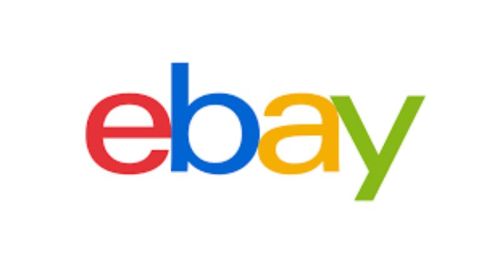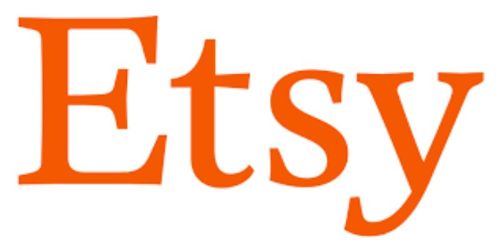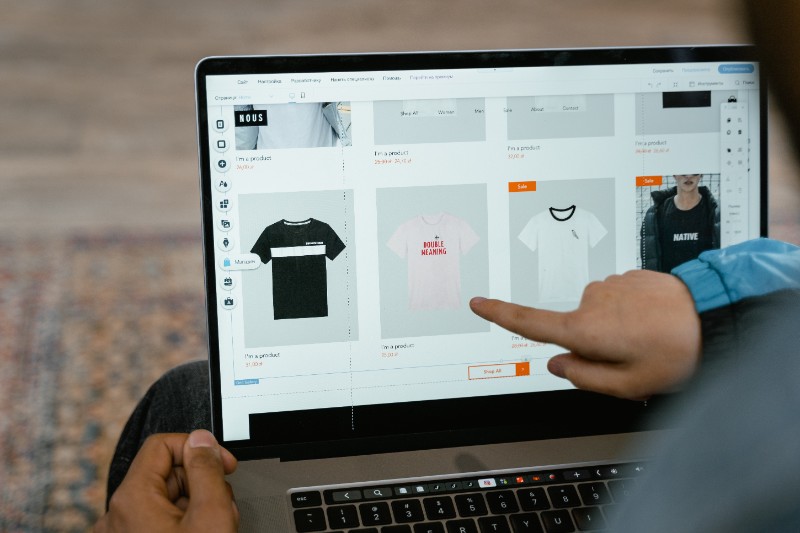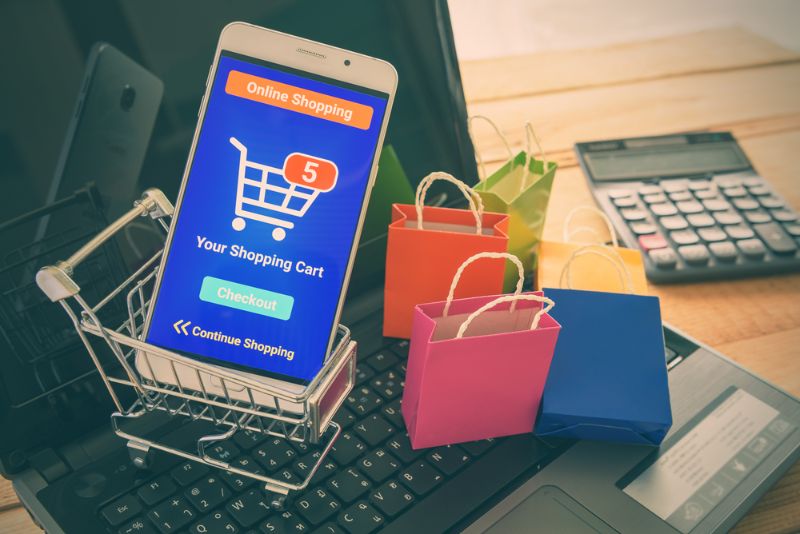The internet has revolutionized how people buy and sell items, providing a global marketplace for individuals and businesses. Selling things online has become increasingly popular for those looking to declutter their homes, sell stuff off, make extra cash, or even start a full-fledged business. With a wide range of platforms available, there’s an opportunity for sellers of all types to find their niche and make a profit.
Navigating the world of online selling can be overwhelming initially, with the sheer number of options for selling sites and strategies available. But, with some research and planning, even the most novice sellers can succeed in this ever-growing market. Some popular platforms to consider when starting your online selling journey include eBay, Mercari, Etsy, and OfferUp, each catering to different products and audiences.
🌟 Top Picks for Online Earnings! 🌟
Dive into our handpicked selection of the best platforms to boost your online income. Trusted by thousands, these platforms are a must-try for anyone looking to make money online.
Turn your opinions into cash with one of the most reputable online survey platforms. Explore Survey Junkie
From watching videos to shopping online, Swagbucks rewards you for everyday online activities. Dive into Swagbucks
Get rewarded for shopping, taking surveys, and more. Check Out Lifepoints
Discover a curated list of remote and flexible jobs. Find Jobs on FlexJobs
As we delve into this adventure, we will explore the varied world of a range of online selling sites, discussing the benefits of each platform and the strategies one can employ to make their online selling experience successful. By delving into these topics, we aim to provide a comprehensive guide for beginners looking to enter the online marketplace and seasoned sellers looking to expand their knowledge.
Popular Online Marketplaces
Amazon

Amazon is the largest ecommerce marketplace in the United States, with over 6 million marketplace sellers and more than 214 million U.S. shoppers per month. In 2019 alone, the marketplace reportedly sold 4,000 items per minute. Some benefits of selling on Amazon include:
- Vast customer base
- Easy to set up a store
- Trustworthy reputation
But, sellers who want to sell there should also consider the competition and possible fees associated with selling on Amazon.
See Related: Is Flash Rewards Legit or a Scam? (Review)
eBay

eBay is another popular online marketplace selling a range of items such as electronics, clothing, and collectibles. Advantages of selling on eBay include:
- Global reach
- Multiple auction or sale formats
- Seller protection program
Remember that eBay charges fees for listing items and final value fees upon selling an item.
Etsy

Etsy caters to a niche market, specializing in handmade goods, art, collectibles, and antiques. Some benefits of selling on Etsy are:
- Targeted audience
- A strong community of sellers
- Easy store setup
Etsy charges a 20¢ listing fee for the listing price of each item.
Facebook Marketplace

Facebook Marketplace is a local selling platform within the Facebook app, allowing users to sell items to people in their surrounding area. Benefits of using Facebook Marketplace include:
- No listing fees
- Wide user base
- Easy communication with buyers
So as you know, sellers need to meet with buyers in person.
Bonanza

Bonanza is a growing online marketplace focusing on fashion, home goods, and unique items. Advantages of selling on a wholesale marketplace on Bonanza include:
- Lower fees than some more significant marketplaces
- Easy store setup
- Import listings from other platforms
OfferUp

OfferUp is a mobile app that allows users to buy and sell items within their local community. Pros of selling stuff locally on OfferUp include:
- No listing fees
- In-app communication with buyers
- Simple to list items
As with Facebook Marketplace, sellers are responsible for meeting with buyers in person.
Poshmark

Poshmark sells and buys new and gently-used clothing, shoes, accessories, and home goods from local buyers. Benefits of using Poshmark to sell items include:
- User-friendly mobile app
- Built-in shipping system
- Social media-style platform
Sellers should note that Poshmark charges a flat service fee only for sales under $15 and a 20% commission fee for sales over $15.
Ruby Lane

Ruby Lane is a platform for selling antiques, vintage items, and art. Some key advantages of trading on Ruby Lane include the following:
- The targeted audience for niche items
- Established reputation
- Comprehensive seller support
Ruby Lane charges monthly fees and listing fees per item.
Swappa

Swappa is a marketplace for buying and selling used electronic devices like smartphones and laptops. Benefits of selling on Swappa include:
- No fees for sellers
- The strict verification process for device quality
- Responsive customer support
Nextdoor

Nextdoor is a private social network for neighborhoods that provides a platform for selling items. Advantages of using Nextdoor sites to sell your items include:
- Local selling
- Familiarity with neighbors
- No listing fees
Craigslist

Craigslist is an online classifieds platform that allows users to post free listings for items they wish to sell online. Benefits of selling on Craigslist include:
- Free listings
- Large user base
- Local selling
But, as with other local selling stuff on online shopping platforms, sellers are responsible for meeting with buyers in person.
See Related: Best Tools & Resources for Online Businesses
Creating Your Online Store

Website Building Platforms
There are a few website-building platforms available to create an online store. Some popular options include:
- Shopify: A robust ecommerce platform offering a range of tools and apps to customize your store and manage sales effectively.
- Wix eCommerce: A user-friendly website builder with customizable templates and features designed specifically for eCommerce.
- Square Online: A platform that integrates with Square’s payment processing, making it easy for businesses to set up an online store and accept payments.
When you choose a platform, please consider the needed features, such as payment gateways, local sales, inventory management, and shipping options. Many platforms, like Shopify, offer a free trial to test their tools before committing to a paid plan.
Branding Your Store
A strong brand is crucial for your online store’s success. Here are some steps to create an effective brand:
- Choose a domain name: This is your store’s web address (e.g., www.yourstore.com). Select a memorable and easy-to-pronounce name that reflects your store’s identity.
- Design a logo: Create a visually appealing logo that represents your brand. You can use online design tools or hire a professional designer to help with this.
- Set a consistent color scheme and typography: Choose colors that represent your brand and use them consistently across your store. Also, select a font that reflects your brand’s personality and is easy to read.
- Write a compelling tagline or slogan: This should be a short, catchy phrase summarizing your store’s offers and its unique selling points.
Once you’ve established your brand, apply it consistently throughout your store. Use the same colors, typography, and other design elements on your website, social media accounts, and marketing materials. This consistency will make your store more recognizable and memorable, attracting and retaining customers.
Product Selection and Research

Finding Winning Products
To find winning products to sell your stuff and, furthermore, online sales, try researching on social media to uncover trending items by searching for hashtags related to your industry. Look for products with high engagement and positive feedback. Identify customer needs by exploring forums and discussion threads where potential buyers express their desires and pain points. Brainstorm a list of ideas, then validate each one through thorough product research.
Another option is using tools like Unicorn Smasher, a completely free browser add-on that provides basic product and revenue information on Amazon listings. You can also opt for a more advanced tool like AMZScout, which offers more features but is priced.
Determining High-Demand Items
To determine the best sites for high-demand items for online sales, follow these steps:
- Market Research: Study the market and identify trends, paying particular attention to seasonal changes, consumer preferences, and popular niches.
- Competitor Analysis: Analyze your competition, taking note of their best-selling products, prices, and marketing strategies to gauge the demand for similar items.
- Pricing Strategy: Research pricing for similar products to establish a competitive price range that maximizes potential profits while remaining attractive to customers.
- Ecommerce Analytics: Utilize ecommerce analytics tools to gain insights into the performance of your product selection, helping you make more informed decisions regarding inventory and sales strategies.
By focusing on product selection/research and using a solid methodology to find winning and high-demand products to sell online, you can effectively increase your chances of success in online sales.
Listing Your Products
When selling things in your own online store, however, listing your products effectively to attract potential buyers and drive sales is crucial. This section covers two crucial aspects of listing your products: Writing Effective Titles and Descriptions and Including Quality Images.
Writing Effective Titles and Descriptions
Creating compelling titles and descriptions is vital for your products to stand out in a marketplace full of competition. Keep the following points in mind while crafting your titles and descriptions:
- Please be accurate and specific: Ensure your title includes relevant details such as brand, model, size, and color. This helps customers find your product quickly and understand what they are purchasing.
- Keep it concise: Avoid long and complicated titles. Stick to the crucial details and use explicit language.
- Use relevant keywords: Incorporate popular search terms related to your product to improve visibility in search results.
- You can highlight unique features: Mention critical features, benefits, or differentiators of your product to pique the interest of potential buyers.
In your product descriptions, provide additional details and specifications about the product, such as:
- Material and build quality
- Functionality and usage
- Compatibility with other devices or accessories (if applicable)
- Any warranties, guarantees, or return policies
Including Quality Images
High-quality images are crucial for showcasing your products effectively. Consider the following tips when selecting and uploading images:
- Resolution: Use high-resolution images that capture the product from different angles, highlighting crucial features and details.
- Background: Opt for a clean, neutral environment that does not distract from the product.
- Consistency: Maintain a consistent image style across all your product listings to create a unified and professional appearance.
- Lighting: Ensure your images are well-lit and avoid using flash whenever possible, which can cause glare and distort colors.
- Include additional images: Provide close-ups of specific features or include photos that demonstrate the product is used to give buyers a better understanding of the item.
Incorporating these tips when listing your products online selling site will help you create informative and appealing listings, attracting potential customers and increasing your chances of making a sale.
Pricing and Fees

Understanding Market Pricing
One of the first steps to selling items online is understanding the market pricing for your products. Research similar items on a range of online marketplaces, such as Amazon, eBay, and Etsy, to determine a competitive price point. Take into account the condition, features, and demand for your product. Also, consider shipping costs and taxes, which may affect your final selling price.
Calculating Fees and Commissions
Online marketplaces often charge fees and commissions for selling items on their platforms. These charges vary depending on the market and the type of product you are selling online.
Amazon
Amazon’s fees are calculated as a percentage of the final value fee of the sales proceeds:
- Fine Art:
- 20% for sales up to $100 (minimum referral fee of $1)
- 15% for sales between $100 and $1,000
- 10% for sales between $1,000 and $5,000
- 5% for sales above $5,000
eBay
On eBay, fees are usually a percentage of the final sale price of the total amount of the sale:
- Sneakers Over $150: 8% of the total sale (no $0.30 per order charge)
- Guitars & Basses:
- 6.35% of the total sale up to $7,500 per item
- 2.35% of the sale amount over $7,500
- $0.30 per order
- Trading Cards: 13.25% of the total sale up to $7,500 per item
Etsy
Etsy has a few fees for sellers:
- Listing fee: $0.20 per item listed
- Transaction fee: 6.5% of the sale amount
- Payment processing fee: 3% of the sale amount plus $0.25
When calculating your potential earnings from online sales, consider both market pricing and the fees and commissions applicable to each platform. This will ensure you maximize your profits and set an attractive price for potential buyers.
See Related: Amazon Shopper Panel Review: Is It Legit or a Scam?
Shipping and Delivery
Shipping Costs
When running an online business, understanding shipping costs and choosing the right shipping provider are crucial for ensuring smooth operations and customer satisfaction. This literary expedition will explore key considerations for selecting a shipping provider and managing shipping costs effectively.
Choosing a Shipping Provider
When selling things online, choosing a reliable shipping provider is crucial. Here are some factors to consider when selecting a service:
- Coverage area: Ensure the provider can deliver to your target market and handle specific geographical challenges.
- Speed: Compare the delivery timeframes offered by a range of providers to suit the urgency of your customers’ demands.
- Pricing: Evaluate shipping rates, and consider offering free shipping on orders above a certain threshold to encourage higher sales.
- Tracking: Customers appreciate being able to monitor the progress of their shipments. You can choose a provider that offers comprehensive tracking capabilities.
Some notable providers include FedEx, UPS, USPS, and DHL. But it’s a good idea to research local and regional options to balance costs and delivery performance.
Handling International Shipping
Expanding your sales to a global audience presents challenges, especially regarding shipping fees and delivery. Here’s what to think about when shipping internationally:
- Customs regulations: Familiarize yourself with the customs requirements for each country you ship to, including necessary documentation, limitations on imported goods, and potentially restricted items.
- Duties and taxes: Be transparent about who pays duties and taxes. Please let me know in your terms and conditions whether the buyer or the seller is responsible for these charges.
- Shipping costs: International shipping can be expensive, so offer multiple options for customers based on their budget and delivery time preferences.
Please remember that fulfilling orders quickly and efficiently is crucial to customer satisfaction. By researching the best shipping providers, you can ensure your customers receive their purchases with minimal complications.
Sell Stuff Online
Selling Handmade Products
Handmade products have a special place in the online marketplace. They are more appealing than mass-produced items because of their uniqueness and personal touch. To get the best value for your handmade items, consider selling them on platforms like Etsy. Etsy caters to niche markets, specifically handmade goods, art, and crafts. To start selling your stuff on Etsy, you must create an account, set up your shop, and list your items with a 20¢ listing fee for each item.
Selling Antiques and Collectibles
Another category of stuff to start selling online that retains its value well in the online market is antiques and collectibles. Platforms like Ruby Lane and Etsy are ideal for selling these items. They cater specifically to niche markets, making it easier for collectors and enthusiasts to find things they are searching for. When listing your antiques or collectibles for sale, include detailed descriptions and high-quality photos to showcase each item’s unique characteristics and condition.
Selling Electronics
Electronic items like smartphones and laptops are always in great demand. To sell these items, ensure they are in good working condition and damage-free. A few websites and apps allow you to sell electronics, including eBay and Amazon. These platforms reach a broad audience and protect both buyers and sellers. When listing your electronics for sale, remember to:
- Could you include detailed descriptions and specifications of the product?
- State the condition of the item (new, used, or refurbished)
- Could you provide high-quality photos to represent the item accurately?
- Compare prices with similar items to set a competitive price.
- Offer a return policy to build trust with potential buyers.
Maximizing
Customer Service and Support

Handling Returns and Refunds
Providing exceptional customer service is crucial when selling items online. Returns and refunds are an inevitable part of online sales, so understanding how to handle them effectively is crucial.
First, could you develop a concise return policy outlining the time frame and conditions for returns and refunds? Please include this policy on your product listings and website to make sure buyers know about the terms. Here are a few key points to consider:
- The time frame for returns: Allow customers a reasonable period, like 14 or 30 days, to return the items.
- Condition of returned items: Specify if things must be in their original packaging or if they need to be unused and undamaged.
- Please don’t forget to be clear on who is responsible for the return shipping costs.
When a customer initiates a return, respond quickly and professionally to their request. Communicate with them through the entire process, providing updates on the status of their refund.
Building Positive Customer Relationships
Developing strong customer relationships is vital for the success of your online business. Here are some strategies for fostering positive relationships with your customers:
- Add a personal touch: Provide personalized communication, such as addressing customers by their names in emails and messages. A little personalization can go a long way in making them feel valued.
- Be transparent and educate customers: Offer accurate and complete product information to help customers make informed decisions. Provide precise shipping and tracking information to avoid potential misunderstandings.
- Please respond quickly to customer feedback: If it’s a question, a concern, or a complaint, responding swiftly and professionally can show customers that you care about their experience.
- Reward repeat customers: Consider offering loyalty programs, exclusive discounts, or special promotions to customers who make multiple purchases from your online store. This can encourage them to continue shopping with you.
Implementing these customer service strategies can help you create a positive user experience, increasing customer satisfaction and loyalty. This, in turn, can lead to more sales and a greater online reputation for your business.
See Related: Best Part-Time Businesses to Start in 2023 & Make Money
Managing Finances and Legalities
When selling things online, managing your finances well and complying with the law is crucial. In this section, we’ll cover the importance of setting up a business bank account and understanding the tax implications of online selling.
Setting Up a Business Bank Account
- Opening a separate business bank account is crucial as it helps to separate your personal and business finances. This will make tracking income, expenses, and taxes easier.
- To open a business bank account, you’ll typically need your business registration documents, Employer Identification Number (EIN), and personal identification.
- Some banks offer specialized accounts for online businesses, which may come with additional benefits such as lower transaction fees, cashback, or integration with accounting software.
Understanding Tax Implications
- Different tax rules may apply depending on your location and the type of products/services you’re selling. Research and comply with your local, state, and federal tax laws.
- In most cases, you’ll be responsible for collecting and remitting sales tax on your online products. Some online marketplaces, like Amazon and eBay, may assist with sales tax collection for a fee.
- Keep track of your income, expenses, and tax liabilities to avoid surprises at the end of the tax year. Consider using accounting software or hiring a professional accountant to assist with tax planning and filing.
By properly managing your finances and staying informed about legal requirements, you can focus on growing your online business while minimizing potential risks and liabilities.
Related Resources:
